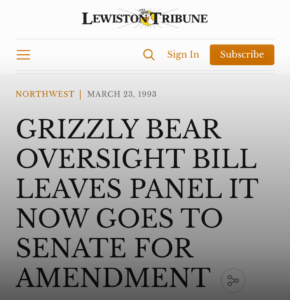We get countless Google alerts about state legislatures and legislative oversight at the State Oversight Academy. Recently, we got a particularly interesting one:

We are not sure why this 1993 article was brought to our attention, but we’re glad it was! While we initially found the phrase, “grizzly bear oversight,” humorous, a closer examination of the Idaho Legislature and grizzlies was quick to bear fruit. With the help of Marissa Fischer at the Idaho Legislative Research Library and some newspaper databases, we started to piece together the story of Idaho’s Grizzly Bear Legislative Oversight Committee and found a fascinating connection to one our advisory board members.
In 1993, while the U.S. Fish and Wildlife Service was preparing a proposal for reintroducing grizzly bears to the Bitterroot Mountains in Idaho and Montana, Idaho State Rep. Charles Cuddy proposed a bill that would create a nine-member committee so the state would have an oversight role in the development of grizzly bear recovery plans. This committee joined the existing Interagency Grizzly Bear Committee that coordinated federal and state-level agencies in Idaho, Montana, Washington, and Wyoming, and a citizen advisory committee to the Idaho Department of Fish & Game. It consisted of the chairs of the House and Senate Resource Committees; representatives from the Idaho Departments of Fish & Game and Agriculture; and representatives from recreation, mining, wildlife, livestock grazing, and timber interests.
The committee was in operation from 1993 until at least 1997, and they largely held public meetings to hear from citizens – who did NOT want grizzlies in their midst. Wolves had recently been reintroduced to the region, and many did not want to see that process repeated.
Between articles detailing the arguments about where bears might be released, why they shouldn’t be, and which committee should oversee the process, a familiar name appeared. Dan Johnson, now the mayor of Lewiston and a member of the State Oversight Academy’s advisory board, was then a consultant for the Resource Organization on Timber Supply (ROOTS). We reached out, hoping he could help us untangle this confusing situation.
Dan explained that ROOTS asked him to bear witness against the grizzly recovery efforts. He looked at the proposed plans and the Endangered Species Act, and found section 10(j), which would allow for the bears to be introduced as a nonessential experimental species. This gives the government more flexibility when deciding how to manage the population. “I told them, ‘I think we can do this!’ And they’re like, ‘Huh? Who are you working for?’” Dan told us.
The Interagency Grizzly Committee had a meeting in Denver, and ROOTS sent him as its representative. Dan isn’t usually the first to raise his hand or give his opinion, but he was paid to be there, so he sat in the front row. When they opened the floor for questions, he was the first to get the microphone.
“I said, ‘We don’t want the damn bear…BUT,’ and then the room gets quiet. ‘If you’re going to bring them back, this is how we propose you do it,’” Dan said.
After the meeting, he was approached by a representative from the Defenders of Wildlife, who was interested in his proposal. They also partnered with the National Wildlife Federation and the Intermountain Forest Industry Association. Together, they spent several years traveling to small towns throughout the region and engaging citizens in the planning process as they developed the ROOTS proposal.
Among other things, the ROOTS proposal included a citizens management committee that would make decisions on issues such as conflicts between bears and livestock and what should happen when they stray onto public lands. In 1995, Rep. Cuddy endorsed the ROOTS proposal. The U.S. Fish and Wildlife Service also expressed support for it.
But then, “Politics killed it,” lamented Dan.
By 1997, Idaho Governor Phil Batt asked the Secretary of the Interior to halt federal plans to reintroduce grizzly bears. The House supported this action by adopting a symbolic memorial. No plan was adopted for grizzly bear recovery.
In Dan’s mayoral office in Lewiston City Hall hangs a large painting of a grizzly bear, standing next to a river in a forest – a gift from the groups he worked with nearly 30 years ago. It was some of the most rewarding work he ever did, even though the effort was ultimately unsuccessful.
Earlier this year, the U.S. Fish and Wildlife Service announced that it was considering plans to reintroduce grizzlies in the Bitterroot Mountains – one of the same regions originally under consideration in Idaho. Dan doesn’t know if his phone will ring, but if it does, he says, “I guess I’ll answer.”